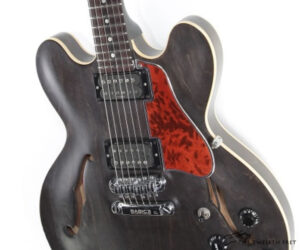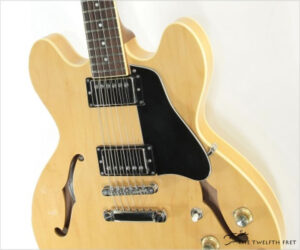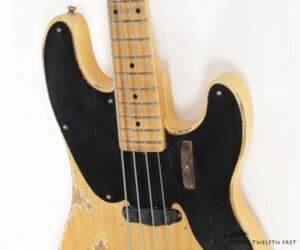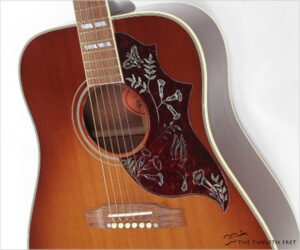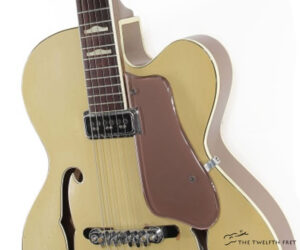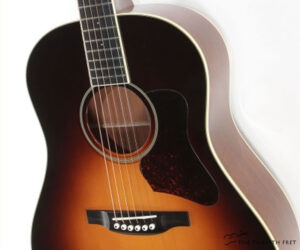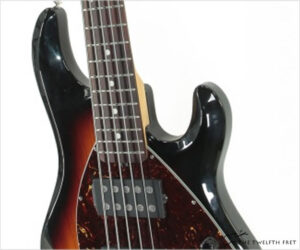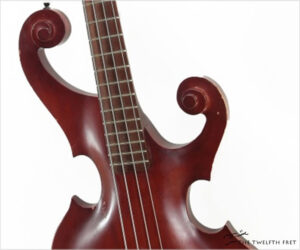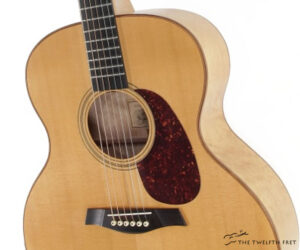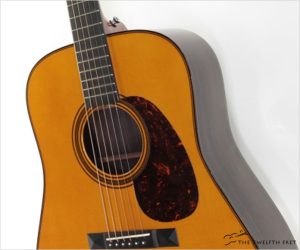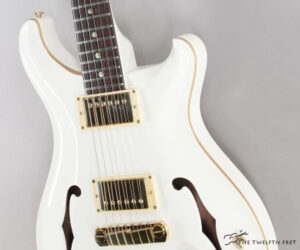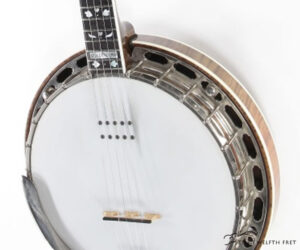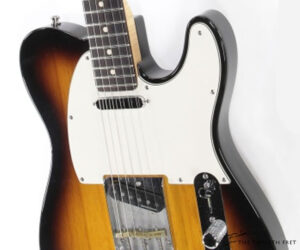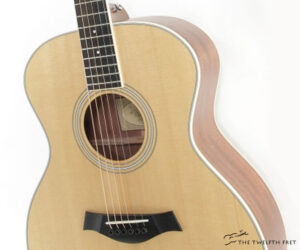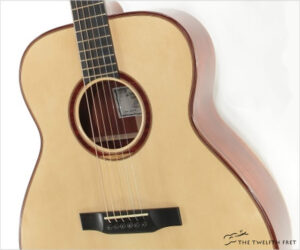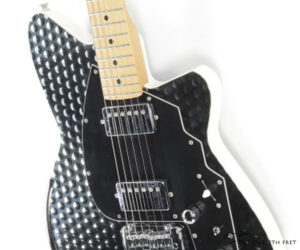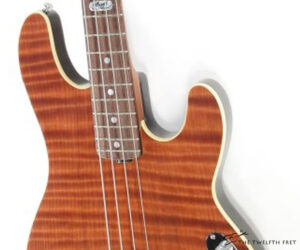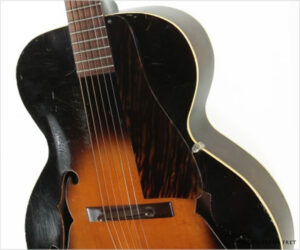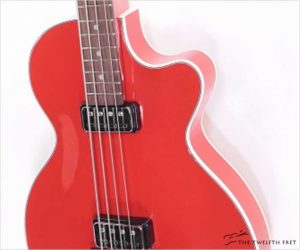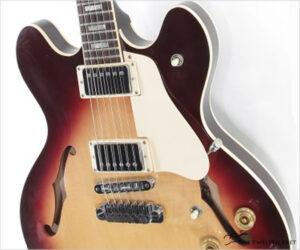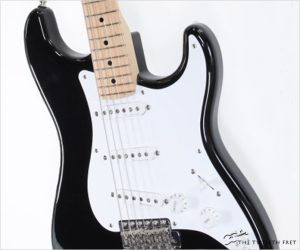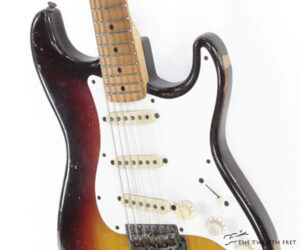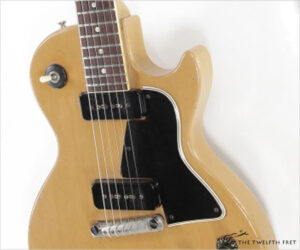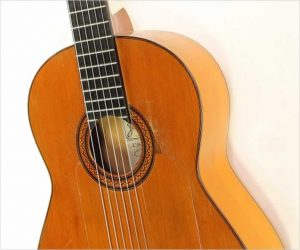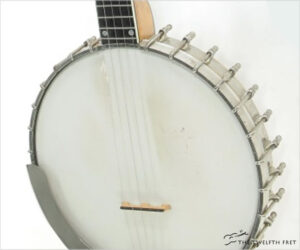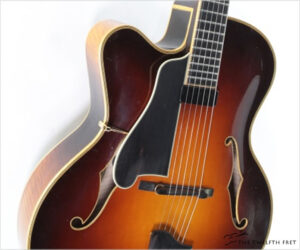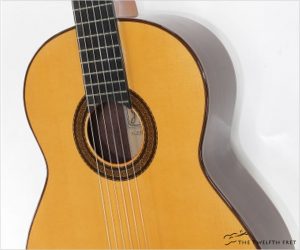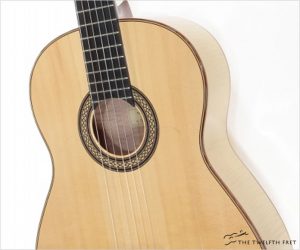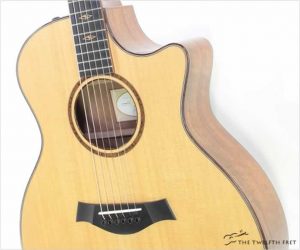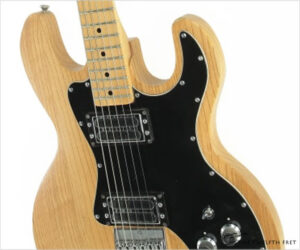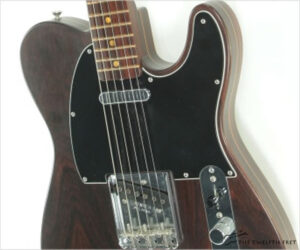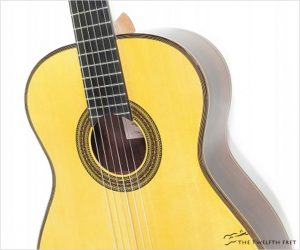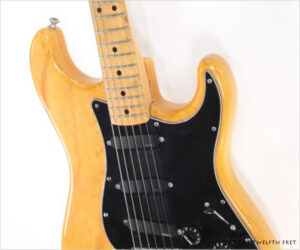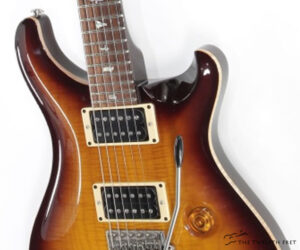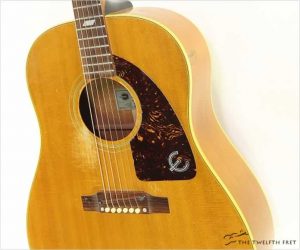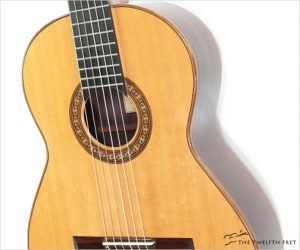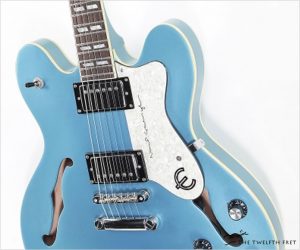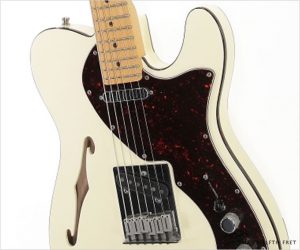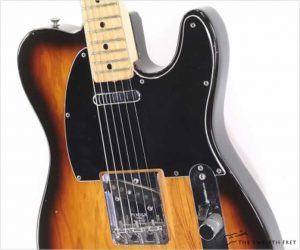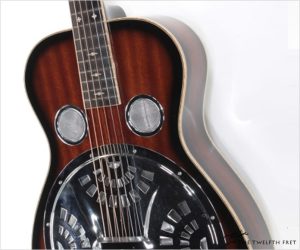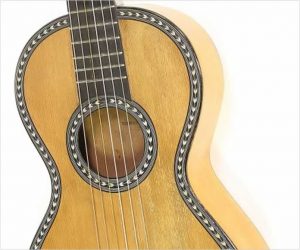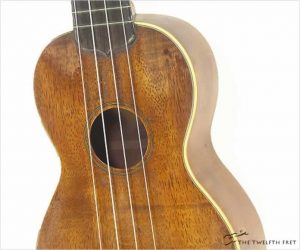For 2006, the Memphis plant introduced the Gibson Satin 335, a somewhat stripped down version of the classic design. Most noticeably, the fingerboard was unbound and the finish is satin – sunburst, cherry or translucent black as seen here. Later versions seem to have restored the fingerboard binding. These models were discontinued with the Memphis plant itself in 2019.
REDUCED
Here is an excellent Epiphone Elitist ES-335 /NA in Natural finish, built during 2006 at the Terada plant in Nagoya, Japan. This is the same plant that builds many pro-line guitars, including Gretsch models, and this guitar illustrates the quality of their work. The Epiphone Elitist ES-335 is based on an early 1960’s Gibson ES-335 with dot position markers, but it is not an exact copy.
For most players, the Fender Vintage Custom 1951 Precision Bass is about as close to an actual original instrument as one can get. This example, dated to early 2019 was refinished, aged and set up by Mike Palermo at Palermo Guitars in mid 2021. It now looks like a well-used 1951 model.
One of a total of 200 built during 2010 and in great shape, this Gibson 50th Anniversary 1960 Hummingbird sports the Heritage Cherry Sunburst finish. The Hummingbird was introduced in 1960 as next to top of the line after the J-200. Gibson dreadnoughts were mostly round-shouldered, but the Hummingbird used the square-shoulder, Martin style body.
Here’s a real beauty – built from 1954 to 1958, the Gretsch Streamliner 6189 was a single pickup version of the 6120. This Gretsch Streamliner 6189 sports the two-tone Bamboo Yellow top and Copper Mist finish and dates to 1957. For the 1957 model year, the headstock changed to remove the vertical ‘Electromatic’ logo and the ‘G-Arrow’ volume and tone control knobs for the deArmond DynaSonic pickup.
The Bourgeois Slope D Custom aims to deliver the sound and feel of pre-WW2 round-shoulder dreadnoughts, a near ideal instrument for flat-picking styles. Dating to October 2005 and built in Lewiston, Maine, this Bourgeois Slope D Custom dreadnought is in very good condition with negligible wear. It features an Adirondack Spruce top, Mahogany for the sides, back, body blocks and neck, Ebony for the bridge, bound head plate and bound fingerboard, and Indian Rosewood for the heel cap.
The EB Music Man StingRay5 HH was the five-string, two pickup version introduced in 2005 as an extension of the classic StingRay bass, itself first appearing in 1976. These solid, well built and versatile 5-string basses became very popular and have been relied on by professional basses.
Here we have a rarity – a very early Les Godfrey Dragonetti bass, built during 2002 at Godfrey’s shop in Toronto, Canada. This bass, serial number 003, is in overall good condition and shows signs of having been used as intended. The design shows the influence of Carl Thompson, with whom Godfrey worked for a time.
Here we have a Marc Beneteau Jumbo steel string acoustic guitar combining Spruce and Maple, built during 1999 in St. Thomas, Ontario. Marc Beneteau has been building guitars since 1974 and his instruments are well built and well respected, and used by stellar players like Don Ross. This Marc Beneteau Jumbo pairs a Sitka Spruce top with figured Maple for the sides, back, and three-piece neck.
This Martin Custom Shop D-28, built during 2014, is a beautiful instrument with a number of subtle differences from stock models.
This PRS McCarty Hollowbody Spruce sports an Antique White finish and as a 1999 model is a very early and excellent condition example. Using the same shapes and layout as the solidbody McCarty models, the PRS McCarty Hollowbody Spruce is fully hollow with a carved Sitka Spruce top and carved Mahogany back, with Mahogany for the sides and neck.
Here we’re looking at a Deering Golden Era 5 string banjo from 2004 with a Kavanjo pickup and capo tacks installed. The Deering Golden Era 5 String Banjo is an accurate reproduction of the classic banjos of the 1930’s made with the same materials and the same weight, design and features of the originals.
From 2006 at the Custom Shop, this Fender Custom American Telecaster sports a sunburst finish and a Glendale bridge plate and saddle set. The Fender Custom American Telecaster starts with a rather full, large ‘C’ profile, AAA grade birdseye Maple neck with an Indian Rosewood fingerboard, paired with a lightweight Ash body.
Built from 2007 to 2012, the Taylor GA3 served as an entry point to the Grand Auditorium line, pairing a Sitka Spruce for the top and braces, with Sapele for the sides and back.
This Sergei de Jonge Steel String Guitar pairs a Sitka Spruce top with Padauk for the sides, back, head plate, backstrap and rosette. Built during 2018 in Chelsea Quebec, it is in very good, clean condition, and delivers a full, rich and complex sound. Like many guitars from the de Jonge shops, this model has a French Polish finish, providing protection to the woods with a minimal imposition on the guitar’s vibration.
The Reverend Rocco was one of Joe Naylor’s first designs around 1996 and this 2002 model is seen with the Bugeye metal top finish. Built in Warren, Michigan during 2002, this example is in very good, clean condition with only light wear. Fairly unusually for Reverend Rocco models, this one is equipped with the Reverend Fulcrum tremolo; apparently this unit was installed to only 65 models.
Here’s something special – an Ernie Ball Music Man Stingray BFR Redwood Top 4-string bass, one of 100 built. These basses feature a highly figured Redwood top on an Ash body, paired to a Mahogany neck with Indian Rosewood fingerboard, patented compensated nut, and Ball Family Reserve octave inlay. The bass is in excellent condition with very little wear.
The Cromwell G-4 archtop guitar was built by Gibson from 1935 to 1939 and sold to various retailers and catalog distributors. Inside this guitar, visible through the bass F-hole is a well-preserved yellow label reading ‘New York Band Instrument Company’ indicating that it was sold by that company, at the time a large music store in New York City, but gone by 1950.
Here’ s a new, old stock 2015 Hofner Gold Label Club Bass in solid red! The Club Bass is also known as the 500/2 – the 500/1 is the iconic violin shaped ‘Beatle Bass’. This is a ‘Gold Label’ model, one of a limited edition in custom colour. These models are built at the primary Hofner plant in Hagenau, Bavaria and are not always easy to find available for sale.
Here we are treated to a real rarity! In 1979, the Gibson ES-335TD CRS – Country Rock Stereo – appeared in a limited run of 300 pieces. These were hot-rodded versions of the standard 335. A less elaborate version, the Country Rock Regular was also sold, with standard mono wiring and stop tailpiece. This example is in good condition with light fret and play wear, but a few marks to the back finish. It plays well, and the electronics setup offers a wide range of tonal options.
Here is a Fender ‘Blackie’ Eric Clapton Signature Stratocaster which was built during 2008 and is in great original condition. This model, introduced in 2004 and built by a team (as distinct from one master builder) features an Alder body and soft-V 22-fret, 9.5 inch radius Maple neck, with a Custom Shop logo and Clapton signature above ‘Blackie’ on the back of the head.
Showing distinct signs of having been used as intended, this Fender Stratocaster Sunburst was built during 1958 in Fullerton, California. Introduced in 1954 as the successor to the Telecaster, work on the Fender Stratocaster began in 1951.
The Gibson Les Paul Special TV model appeared in 1955, with the ‘TV’ referring to a special ‘limed’ finish intended to make the guitar more visible on black and white televisions and films. This finish had become available in 1954 on the Les Paul TV, a single-pickup Les Paul Junior. Both models used a slab Mahogany body with no Maple cap, and a Mahogany neck, with a bound Rosewood fingerboard, which into the mid 1960’s meant Brazilian Rosewood.
Ramirez 1a flamenco guitars are built in the traditional Spanish style at the ‘home’ workshop. The guitar centers on a ‘slipper foot’ neck to body joint, with the sides fitting into slots cut into the heel block. The body pairs a Spruce top with Cypress back and sides – a very light wood in terms of weight and colouring, also providing a lot of brightness to the tone.
Combining classic D body construction and ’42’ style trim, this 2007 Collings D-42A dreadnought pairs Adirondack Spruce with Indian Rosewood. This sonic cannon delivers much more than good looks and top quality construction. Now out of production, the Collings D-42A sat at the top of Collings’ ‘Traditional’ line.
Following its original form as an A.C Fairbanks product, the Fairbanks Vega Whyte Laydie featured a natural finish on the maple neck and pot which provided its name. However, the real innovation was the Whyte Ladyie tone ring and bracket band, reducing the number of holes drilled and adding mass to the pot.
The Eastman AR910CE LH – Left Handed – is pretty much the top of the Eastman line of archtop electrics, with solid wood throughout and carved top and back. It’s fairly unusual to see an available high quality left-handed archtop. The top and its bracing are solid Spruce, paired with nicely flamed and matched Flame Maple for the sides and back.
The Ramirez 1a or Tradicional, seen here with a Spruce top, has for been a benchmark of top quality classical and flamenco guitars for over half a century. The 1a designation technically refers to the quality of the materials and workmanship, but has become associated with the Tradicional model.
Here is another fine and unusual guitar, a Kolya Panhuyzen Maple Body Classical model built in Toronto, Canada during 1987. Kolya Panhuyzen grew up around classical guitar construction and worked with his uncle, Edgar Monch, in both Germany and Toronto.
Here’s a great deal on a New, Old Stock (NOS) Taylor Custom GA in Spruce and Figured Walnut, dating to early 2015 and at a significant price reduction! As the name suggests, the Taylor Custom GA is from Taylor’s Custom programme, sometimes known as BTO or ‘Build To Order’. The GA stands for Grand Auditorium, one of the larger body sizes but smaller than a Jumbo or Dreadnought.
Introduced in late 1977 for the 1978 model year, the Peavey T-60 and its mate the T-40 bass were the first wave of Peavey guitars. Well built, versatile and relatively inexpensive, these instruments rapidly became fairly popular. The T-60’s production ran from 1978 to 1988. Here we’re looking at an early Peavey T-60, built during 1978 in Meridian, Mississippi.
The Fender Rosewood Telecaster ’69 Reissue was built by the Fender Custom Shop during 2007 as a limited release ending December 31 of that year. Few of the originals were built or sold. The most well known of the Fender Rosewood Telecasters was the one owned by George Harrison, used on the Let It Be album and the ill-fated rooftop concert.
Built in a tiny corner of the USA, this Darren Hippner Romanillos style classical guitar illustrates why its maker has such a good reputation. This slightly short-scale guitar – 25 inches or 635mm- was built during 2012 and no longer appears in his listing of available models.
This Fender Stratocaster Natural, has an Ash body with Maple neck and was built during 1977 in Fullerton California and with a few period modifications – a brass nut and saddles, and EMG pickups. During the 1970’s and 1980’s, many players sought new ways to customize their instruments for new sounds and capabilities, and this led to the proliferation of third-party parts and pickup suppliers.
The PRS Custom 24 is the guitar that really started PRS in the production guitar world at the end of 1985. Blending the best elements of other designs in an elegant and attractive package, the Custom 24 has been at the core of the PRS line since its introduction.
The Epiphone Texan FT79N – the N indicating a Natural finish on the top rather than Sunburst – was built as a slope shoulder dreadnought from 1958 to 1970 when Epiphone production ceased in the USA. The Epiphone FT79 was originally built from 1941 to 1958 as a square shoulder dreadnought with Walnut back and sides until 1949, and then with laminated Maple until the company was sold to Gibson in 1958.
This Sergei de Jonge Classical guitar was built during 1980 in Toronto, following de Jonge’s return to Canada from a year in Holland and creation of a new workshop. Having learned guitar building in Toronto during the years 1969 to 1971 from Jean Larrivee and Edgar Monch via Eli Kassner, and then a year with Patt Lister in Collingwood, this de Jonge classical shows these strong influences.
Influenced heavily by the Sheraton used by Noel Gallagher in Oasis, the Epiphone Supernova was built from 1997 to 2005, with a signature pickguard and features making it the Noel Gallagher Supernova. It was available in a variety of finishes including the Manchester Blue seen here, and a custom Union Jack graphic.
The Fender Thinline Telecaster was introduced in 1969 as a design by Roger Rossmeisl, who had done major work for Rickenbacker. There have been a few versions of this model, and this particular 1998 example seems to me one of the best ever.
Since its introduction as the Broadcaster in 1950 as the world’s first two-pickup, solidbody electric guitar, the Fender Telecaster has gone from strength to strength. It has been used in virtually every musical context that accepts electric instruments, and many musicians have built careers on its use. It’s truly an inspired design. Here we’re looking at a Fender Telecaster Maple Neck in Sunburst finish and largely original condition, built during 1978 in Fullerton, California during the CBS era.
The Beard Legacy R RoundNeck features a small Mahogany body and neck with Ebony fingerboard, with a single-cone spider-type resonator set. This example dates to 2008 at Hagerstown, Maryland and includes a factory-installed pickup, custom built by Beard with Jerry Douglas and Larry Fishman.
Here’s something special, a lovely Romantic Era guitar built by Francois Tachet in Mirecourt, northeastern France, during the 1830s or early 1840s. Mirecourt has long been known for making musical instruments and lace; instruments from the area are often referred to as from the Mirecourt School. Louis Panormo was a contemporary, working in London. This Francois Tachet romantic guitar – at approximately 185 years old – is in good working order, and has had some expected service over the decades.
